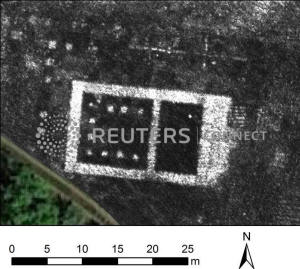Ground-penetrating radar reveals splendor of ancient Roman city
 Send a link to a friend
Send a link to a friend
 [June 09, 2020]
By Will Dunham [June 09, 2020]
By Will Dunham
WASHINGTON (Reuters) - In a glimpse into
the future of archeology, researchers have used ground-penetrating radar
to map an entire ancient Roman city, detecting remarkable details of
buildings still deep underground including a temple and a unique public
monument.
The technology was used at Falerii Novi, a walled city spanning 75 acres
(30.5 hectares) about 30 miles (50 km) north of Rome, researchers said
on Monday.
Falerii Novi was founded in 241 BC during the time of the Roman Republic
and was inhabited until around 700 AD in the early Middle Ages.
It marked the first time a complete ancient city was mapped using
ground-penetrating radar (GPR), which lets researchers explore
large-scale archeological sites expeditiously without excavation, which
can be costly and time-consuming.

The technology can "see" beneath the surface using a radar antenna that
sends a pulsed radio signal into the ground and listens for the echoes
bouncing off objects. The GPR equipment was pulled over the surface
using an all-terrain vehicle.
"This took one person about three to four months in the field," said
Martin Millett, a University of Cambridge classical archaeology
professor who helped lead the study published in the journal Antiquity.
"This really does change how we can study and understand Roman towns -
the way of the future for archaeology."
[to top of second column]
|

A slice of Ground Penetrating Radar (GPR) data from the ancient
Roman city of Falerii Novi in Italy revealing the outlines of the
town's buildings is shown in this image released on May 8, 2020. L.
Verdonck/Handout via REUTERS

Falerii Novi, not quite half the size of ancient Pompeii, had
previously been partially excavated but most remained buried. With a
population of perhaps 3,000 people, it boasted an unexpectedly
elaborate public bath complex and market building, at least 60 large
houses and a rectangular temple with columns near the city's south
gate.
Near the north gate was a public monument unlike any other known,
with a colonnaded portico on three sides and a large open square
measuring 130 by 300 feet (40 by 90 meters). Falerii Novi had a
network of water pipes running beneath the city blocks and not just
along streets, indicating coordinated city planning.
(Reporting by Will Dunham; Editing by Sandra Maler)
[© 2020 Thomson Reuters. All rights
reserved.] Copyright 2020 Reuters. All rights reserved. This material may not be published,
broadcast, rewritten or redistributed.
Thompson Reuters is solely responsible for this content.
 |